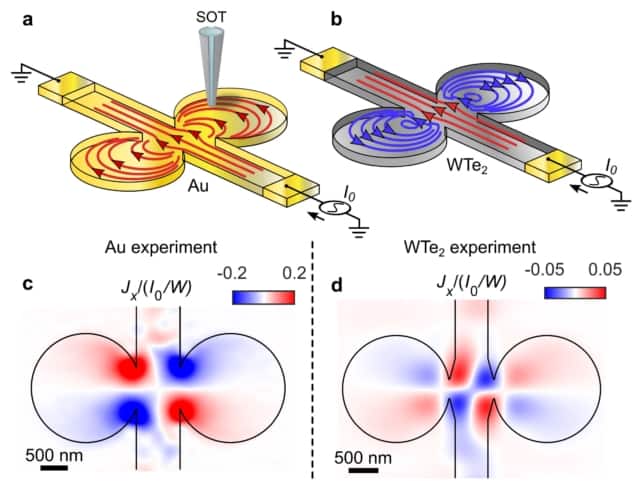
An international team of physicists has observed electrons flowing in whirlpool-like patterns known as vortices for the first time. Long predicted, but never before seen in experiments, this evidence of fluid-like behaviour could be exploited to make more efficient electronics.
In ordinary materials, the flow of electrons is strongly influenced by impurities and atomic vibrations, both of which cause electrons to scatter. In ultraclean materials and at near-zero temperatures, where such classical processes are absent, the electrons move unimpeded across the material, like billiard balls. In the rare cases, however, when the electrons are strongly interacting between themselves, the electrons are predicted to move collectively, like a fluid.
In 2017, a team led by Leonid Levitov at the Massachusetts Institute of Technology in the US, together with colleagues at the University of Manchester in the UK, observed fluid-like electron behaviour in a sample of graphene (a sheet of carbon atoms just one atom thick) that contained a thin channel with several pinch points. Current sent through the channel flowed through the constrictions with hardly any resistance, implying that the electrons that make up the current could squeeze through the pinch points collectively rather than passing through them individually.
Electrons behave like quantum waves
In the new work, Eli Zeldov, together with Levitov and colleagues from Israel’s Weizmann Institute of Science and the University of Colorado at Denver in the US, studied electrons in tungsten ditelluride (WTe2). This material is an ultraclean type II Weyl semimetal, a recently discovered class of topological material (one that can be insulating in the bulk but has conducting surface states due to symmetry-protected topological order). WTe2 is known to have exotic electronic properties when made into two-dimensional flakes a single atom thick. Indeed, it is one of several new quantum materials in which electrons interact strongly and behave as quantum waves rather than particles, Levitov explains.
To observe electrons flowing in vortices, the researchers first synthesized pure single crystals of WTe2 and shaved off thin flakes of the material. They then used electron-beam lithography and plasma etching to pattern each flake into a narrow channel and two circular chambers connected to its sides.
“This geometry was designed to allow possible shear forces to steer the electron fluid in the chambers by the electric current flowing in the narrow channel,” team member Amit Aharon-Steinberg tells Physics World. “We then used an extremely sensitive scanning magnetometer, designed in our laboratory, which senses the magnetic fields generated by the flowing electric current.”
Finally, the researchers reconstructed the electric current from the measured magnetic field images to explicitly highlight the vortices.
The hydrodynamic regime
The analyses revealed that electrons flowing through the channel caused the electrons in each side chamber to swirl in whirlpools. What is more, the vortices were only present for small apertures, with the flow being laminar (that is, without vortices) for larger ones. Near the vortical-to-laminar transition, a single vortex in the chamber was seen splitting into two – behaviour that is only expected in the hydrodynamic (fluid-like) regime.

Electrons flow like a fluid in a metal superconductor
The findings suggest that a new hydrodynamic mechanism in thin pure crystals may exist such that the diffusion of the momentum of electrons is enabled by small-angle scattering on the surface of the material rather than conventional electron-electron scattering, which becomes very weak at low temperatures. This surface-induced para-hydrodynamics, as the researchers have dubbed it, shares many of aspects of ordinary hydrodynamics, including vortices.
According to the Weizmann-MIT-Colorado team, the findings could help researchers design and develop more efficient electronics. “We know when electrons go in a fluid state, [energy] dissipation drops, and that’s of interest in trying to design low-power electronics,” Levitov says. “This new observation is another step in that direction.”
The research is detailed in Nature.
